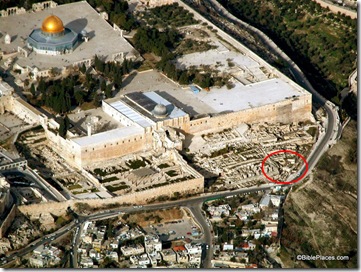Concerning Mazar’s “discoveries” announced earlier today, I think that some readers would be interested in the report given in the New Encyclopedia of Archaeological Excavations in the Holy Land (1993). A section on the Ophel was written by Hillel Geva and I quote it at length because (1) it reveals what was discovered in the previous excavation that appears to be re-reported as new today and (2) it indicates that the identification of the building as a gate was the excavator’s identification.
I have marked some statements in bold for emphasis.
In 1986 to 1987, B. Mazar and E. Mazar continued to excavate the complex of Iron Age II public buildings in the southeastern part of the Ophel. The buildings were partially unearthed in B. Mazar’s 1970 excavations; he identified them as remains of the biblical “house of Millo.” The renewed excavations revealed many additional remains that add up to a complex of several interconnected, but well-defined building units. The quality of the construction is impressive, featuring thick walls founded on bedrock, sometimes preserved to a height of some 4 m. The first stages of these buildings date to the ninth century BCE, at the earliest; they were destroyed, together with the rest of Jerusalem in 586 BCE, as the visible signs of destruction and conflagration indicate.
The remains of building C consisted of the walls of two rooms, the foundations of the walls of other rooms, and sections of floors. They have been identified as belonging to a four-chamber gatehouse of the type characteristic of the Iron Age II. The earlier excavations had exposed dozens of vessels, including many storage jars, in the gate’s southwestern chamber. Building D, which adjoins building C on the east, consisted of several rooms, in which pithoi [large storage jars] were found, suggesting that the building was a storehouse.
The various building units combined to form a dense complex whose outer walls created a continuous line of fortifications along the eastern side of the Ophel, overlooking the Kidron Valley. The gate may be associated with the large tower (building B) to the south, discovered by Warren in the Ophel wall between 1867 and 1870, and with another, smaller tower (building A) whose eastern side Kenyon exposed in 1967 in her site SII.
The gate has been identified with the biblical “Water Gate” (Neh. 3:26) that was part of the complex known as the “upper house of the king.” The excavators believe that it was a gate in the western section of the Jerusalem city wall, providing access to a separate royal quarter, which stood on the Ophel until the end of the First Temple period (Vol. 2, p. 715).
Given this report, I cannot determine what, if anything, has been discovered recently. The only thing that appears to have changed is the date (back now to the time of Solomon).
